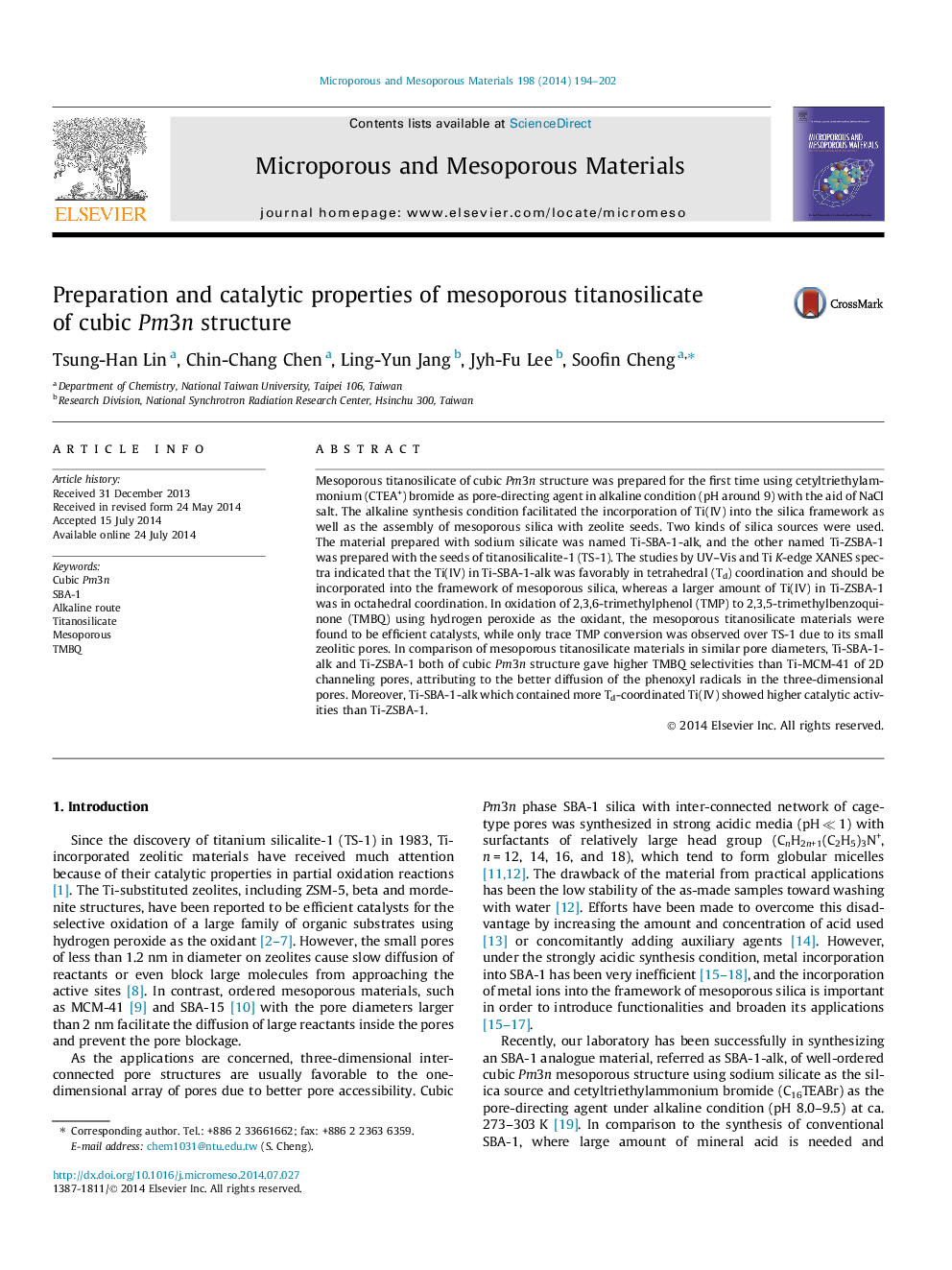| کد مقاله | کد نشریه | سال انتشار | مقاله انگلیسی | نسخه تمام متن |
|---|---|---|---|---|
| 72949 | 49038 | 2014 | 9 صفحه PDF | دانلود رایگان |

• Titanosilicate of cubic Pm3n mesostructure was prepared from sodium silicate or TS-1 zeolite seeds.
• Ti(IV) in Ti-SBA-1-alk assembly from sodium silicate was mainly in tetrahedral coordination.
• A large amount of Ti(IV) in Ti-ZSBA-1 assembly from TS-1 was in octahedral coordination.
• In oxidation of 2,3,6-TMP with H2O2, Ti-SBA-1-alk gave higher TMBQ selectivities than Ti-MCM-41.
• Better diffusion of the phenoxyl radicals in 3D interconnected pores than in 2D channeling pores.
Mesoporous titanosilicate of cubic Pm3n structure was prepared for the first time using cetyltriethylammonium (CTEA+) bromide as pore-directing agent in alkaline condition (pH around 9) with the aid of NaCl salt. The alkaline synthesis condition facilitated the incorporation of Ti(IV) into the silica framework as well as the assembly of mesoporous silica with zeolite seeds. Two kinds of silica sources were used. The material prepared with sodium silicate was named Ti-SBA-1-alk, and the other named Ti-ZSBA-1 was prepared with the seeds of titanosilicalite-1 (TS-1). The studies by UV–Vis and Ti K-edge XANES spectra indicated that the Ti(IV) in Ti-SBA-1-alk was favorably in tetrahedral (Td) coordination and should be incorporated into the framework of mesoporous silica, whereas a larger amount of Ti(IV) in Ti-ZSBA-1 was in octahedral coordination. In oxidation of 2,3,6-trimethylphenol (TMP) to 2,3,5-trimethylbenzoquinone (TMBQ) using hydrogen peroxide as the oxidant, the mesoporous titanosilicate materials were found to be efficient catalysts, while only trace TMP conversion was observed over TS-1 due to its small zeolitic pores. In comparison of mesoporous titanosilicate materials in similar pore diameters, Ti-SBA-1-alk and Ti-ZSBA-1 both of cubic Pm3n structure gave higher TMBQ selectivities than Ti-MCM-41 of 2D channeling pores, attributing to the better diffusion of the phenoxyl radicals in the three-dimensional pores. Moreover, Ti-SBA-1-alk which contained more Td-coordinated Ti(IV) showed higher catalytic activities than Ti-ZSBA-1.
Mesoporous titanosilicate of cubic Pm3n structure, which was prepared for the first time using cetyltriethylammonium (CTEA+) bromide as pore-directing agent in alkaline condition (pH around 9), gave higher TMBQ selectivities in oxidation of 2,3,6-trimetylphenol with H2O2 than Ti-MCM-41 of 2D channeling pores, attributing to the better diffusion of the phenoxyl radicals in the three-dimensional pores.Figure optionsDownload as PowerPoint slide
Journal: Microporous and Mesoporous Materials - Volume 198, 1 November 2014, Pages 194–202